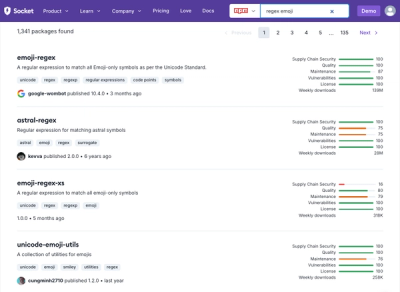
Security News
Weekly Downloads Now Available in npm Package Search Results
Socket's package search now displays weekly downloads for npm packages, helping developers quickly assess popularity and make more informed decisions.
Lightweight wrapper for PyTorch that provides a simple unified interface for context switching between devices (CPU, GPU), distributed modes (DDP, Horovod), mixed-precision (AMP, Apex), and extensions (fairscale, deepspeed).
Add a little accelerant to your torch



stoke is a lightweight wrapper for PyTorch that provides a simple declarative API for context switching between
devices (e.g. CPU, GPU), distributed modes, mixed-precision, and PyTorch extensions. It places no restrictions on code
structure for model architecture, training/inference loops, loss functions, optimizer algorithm, etc. Stoke simply
'wraps' your existing PyTorch code to automatically handle the necessary underlying wiring for all of the
supported backends.This allows you to switch from local full-precision CPU to mixed-precision distributed multi-GPU
with extensions (like optimizer state sharding) by simply changing a few declarative flags. Additionally, stoke
exposes configuration settings for every underlying backend for those that want configurability and raw access to
the underlying libraries.
In short, stoke is the best of
PyTorch Lightning Accelerators
disconnected from the rest of PyTorch Lightning. Write whatever PyTorch code you want, but leave device and backend
context switching to stoke.
stoke handle the restmodel, loss, backward, and step callsattrs interface for all backend configuration parameters (with docstrings)If you are planning on using mixed-precision (aka FP16), please install Apex so that stoke supports all FP16 methods.
If you are not planning on using mixed precision, this step can actually be skipped (as all imports are in a try/except
and are only conditionally imported).
Follow the instructions here.
Note: MPI support is necessary if you plan to run Stoke across multiple compute nodes (e.g. 2 nodes with 4 GPUs each) with DDP, Horovod, or DeepSpeed backends
Follow the instructions here or here
Also, refer to the Dockerfile here
pip install stoke
Note: MPI support is necessary if you plan to run Stoke across multiple compute nodes (e.g. 2 nodes with 4 GPUs each) with DDP, Horovod, or DeepSpeed backends
pip install stoke[mpi]
Full documentation can be found here and examples are here.
Assuming some already existing common PyTorch objects (dataset: torch.utils.data.Dataset, model: torch.nn.Module,
loss: torch.nn.(SomeLossFunction)):
import torch
# Some existing user defined dataset using torch.utils.data.Dataset
class RandomData(torch.utils.data.Dataset):
pass
# An existing model defined with torch.nn.Module
class BasicNN(torch.nn.Module):
pass
# Our existing dataset from above
dataset = RandomData(...)
# Our existing model from above
model = BasicNN(...)
# A loss function
loss = torch.nn.BCEWithLogitsLoss()
stoke requires a slightly different way to define the optimizer (as it handles instantiation internally) by using
StokeOptimizer. Pass in the uninstantiated torch.optim.* class object and any **kwargs that need to be passed to the
__init__ call:
from stoke import StokeOptimizer
from torch.optim import Adam
# Some ADAM parameters
lr = 0.001
beta1 = 0.9
beta2 = 0.98
epsilon = 1E-09
# Create the StokeOptimizer
opt = StokeOptimizer(
optimizer=Adam,
optimizer_kwargs={
"lr": lr,
"betas": (beta1, beta2),
"eps": epsilon
}
)
Now create the base stoke object. Pass in the model, loss(es), and StokeOptimizer from above as well as any
flags/choices to set different backends/functionality/extensions and any necessary configurations. As an example,
we set the device type to GPU, use the PyTorch DDP backend for distributed multi-GPU training, toggle native PyTorch
AMP mixed precision, add Fairscale optimizer-state-sharding (OSS), and turn on automatic gradient accumulation and
clipping (4 steps and clip-by-norm). In addition, let's customize PyTorch DDP, PyTorch AMP and Fairscale OSS with
some of our own settings but leave all the others as default configurations.
import os
from stoke import AMPConfig
from stoke import ClipGradNormConfig
from stoke import DDPConfig
from stoke import DistributedOptions
from stoke import FairscaleOSSConfig
from stoke import FP16Options
from stoke import Stoke
# Custom AMP configuration
# Change the initial scale factor of the loss scaler
amp_config = AMPConfig(
init_scale=2.**14
)
# Custom DDP configuration
# Automatically swap out batch_norm layers with sync_batch_norm layers
# Notice here we have to deal with the local rank parameter that DDP needs (from env or cmd line)
ddp_config = DDPConfig(
local_rank=os.getenv('LOCAL_RANK'),
convert_to_sync_batch_norm=True
)
# Custom OSS configuration
# activate broadcast_fp16 -- Compress the model shards in fp16 before sharing them in between ranks
oss_config = FairscaleOSSConfig(
broadcast_fp16=True
)
# Configure gradient clipping using the configuration object
grad_clip = ClipGradNormConfig(
max_norm=5.0,
norm_type=2.0
)
# Build the object with the correct options/choices (notice how DistributedOptions and FP16Options are already provided
# to make choices simple) and configurations (passed to configs as a list)
stoke_obj = Stoke(
model=model,
optimizer=opt,
loss=loss,
batch_size_per_device=32,
gpu=True,
fp16=FP16Options.amp.value,
distributed=DistributedOptions.ddp.value,
fairscale_oss=True,
grad_accum_steps=4,
grad_clip=grad_clip,
configs=[amp_config, ddp_config, oss_config]
)
Next we need to create a torch.utils.data.DataLoader object. Similar to the optimizer definition this has to be done
a little differently with stoke for it to correctly handle each of the different backends. stoke provides a mirrored
wrapper to the native torch.utils.data.DataLoader class (as the DataLoader method) that will return a correctly
configured torch.utils.data.DataLoader object. Since we are using a distributed backend (DDP) we need to provide a
DistributedSampler or similar class to the DataLoader. Note that the Stoke object that we just created has the
properties .rank and .world_size which provide common interfaces to this information regardless of the backend!
from torch.utils.data.distributed import DistributedSampler
# Create our DistributedSampler
# Note: dataset is the torch.utils.data.Dataset from the first section
sampler = DistributedSampler(
dataset=dataset,
num_replicas=stoke_obj.world_size,
rank=stoke_obj.rank
)
# Call the DataLoader method on the stoke_obj to correctly create a DataLoader instance
# The DataLoader object already known the batch size from the Stoke object creation
data_loader = stoke_obj.DataLoader(
dataset=dataset,
collate_fn=lambda batch: dataset.collate_fn(batch), # note: this is optional depending on your dataset
sampler=sampler,
num_workers=4
)
Stoke provides access to each of the underlying PyTorch instances/objects/classes it's managing. Any created Stoke
object has multiple @property methods that return the underlying attribute(s) such as .optimzer, .loss_access,
.model_access, .step_loss, etc. Therefore, to use a PyTorch LR Scheduler it's as simple as getting the underlying
optimizer and passing it to the LR Scheduler constructor:
from torch.optim.lr_scheduler import OneCycleLR
scheduler = OneCycleLR(
stoke_obj.optimizer,
max_lr=0.001,
pct_start = 0.9,
epochs=100,
steps_per_epoch=len(data_loader)
)
At this point, we've successfully configured stoke! Since stoke handled wrapping/building your torch.nn.Module and
torch.utils.data.DataLoader, device placement is handled automatically (in our example the model and data are moved
to GPUs). The following simple training loop should look fairly standard, except that the model forward, loss,
backward, and step calls are all called on the Stoke object instead of each individual component (as it
internally maintains the model, loss, and optimizer and all necessary code for all
backends/functionality/extensions). In addition, we use one of many helper functions built into stoke to print the
synced and gradient accumulated loss across all devices (an all-reduce across all devices with ReduceOp.SUM and divided
by world_size -- that is print only on rank 0 by default)
epoch = 0
# Iterate until number epochs
while epoch < 100:
# Loop through the dataset
for x, y in data_loader:
# Use the Stoke wrapped version(s) of model, loss, backward, and step
# Forward
out = stoke_obj.model(x)
# Loss
loss = stoke_obj.loss(out, y.to(dtype=torch.float).unsqueeze(1))
# Detach loss and sync across devices -- only after grad accum step has been called
stoke_obj.print_mean_accumulated_synced_loss()
# Backward
stoke_obj.backward(loss)
# stoke_obj.dump_model_grads()
# Optimizer Step
stoke_obj.step()
# Scheduler Step -> Note this is the order for PyTorch 1.10, for < 1.10 the scheduler step is before the
# optimizer step
scheduler.step()
epoch += 1
stoke provides a unified interface to save and load model checkpoints regardless of backend/functionality/extensions.
Simply call the save or load methods on the Stoke object.
# Save the model w/ a dummy extra dict
path, tag = stoke_obj.save(
path='/path/to/save/dir',
name='my-checkpoint-name',
extras={'foo': 'bar'}
)
# Attempt to load a saved checkpoint -- returns the extras dictionary
extras = stoke_obj.load(
path=path,
tag=tag
)
See the documentation here
Certain combinations of backends/functionality are not compatible with each other. The below table indicates which combinations should work together:
| Backends/Devices | CPU | GPU | PyTorch DDP | Deepspeed DDP | Horovod | Deepspeed FP16 | Native AMP | NVIDIA APEX | Deepspeed ZeRO | Fairscale |
|---|---|---|---|---|---|---|---|---|---|---|
| CPU | ||||||||||
| GPU | ✔ | ✔ | ✔ | ✔ | ✔ | ✔ | ✔ | |||
| PyTorch DDP | ✔ | ✔ | ✔ | ✔ | ||||||
| Deepspeed DDP | ✔ | ✔ | ✔ | |||||||
| Horovod | ✔ | ✔ | ✔ | |||||||
| DeepspeedFP16 | ✔ | ✔ | ✔ | ✔ | ||||||
| Native AMP | ✔ | ✔ | ✔ | ✔ | ||||||
| NVIDIA APEX | ✔ | ✔ | ✔ | |||||||
| Deepspeed ZeRO | ✔ | ✔ | ✔ | |||||||
| Fairscale | ✔ | ✔ | ✔ |
stoke is developed and maintained by the Artificial Intelligence Center of Excellence at Fidelity Investments.
FAQs
Lightweight wrapper for PyTorch that provides a simple unified interface for context switching between devices (CPU, GPU), distributed modes (DDP, Horovod), mixed-precision (AMP, Apex), and extensions (fairscale, deepspeed).
We found that stoke demonstrated a healthy version release cadence and project activity because the last version was released less than a year ago. It has 1 open source maintainer collaborating on the project.
Did you know?

Socket for GitHub automatically highlights issues in each pull request and monitors the health of all your open source dependencies. Discover the contents of your packages and block harmful activity before you install or update your dependencies.

Security News
Socket's package search now displays weekly downloads for npm packages, helping developers quickly assess popularity and make more informed decisions.

Security News
A Stanford study reveals 9.5% of engineers contribute almost nothing, costing tech $90B annually, with remote work fueling the rise of "ghost engineers."

Research
Security News
Socket’s threat research team has detected six malicious npm packages typosquatting popular libraries to insert SSH backdoors.